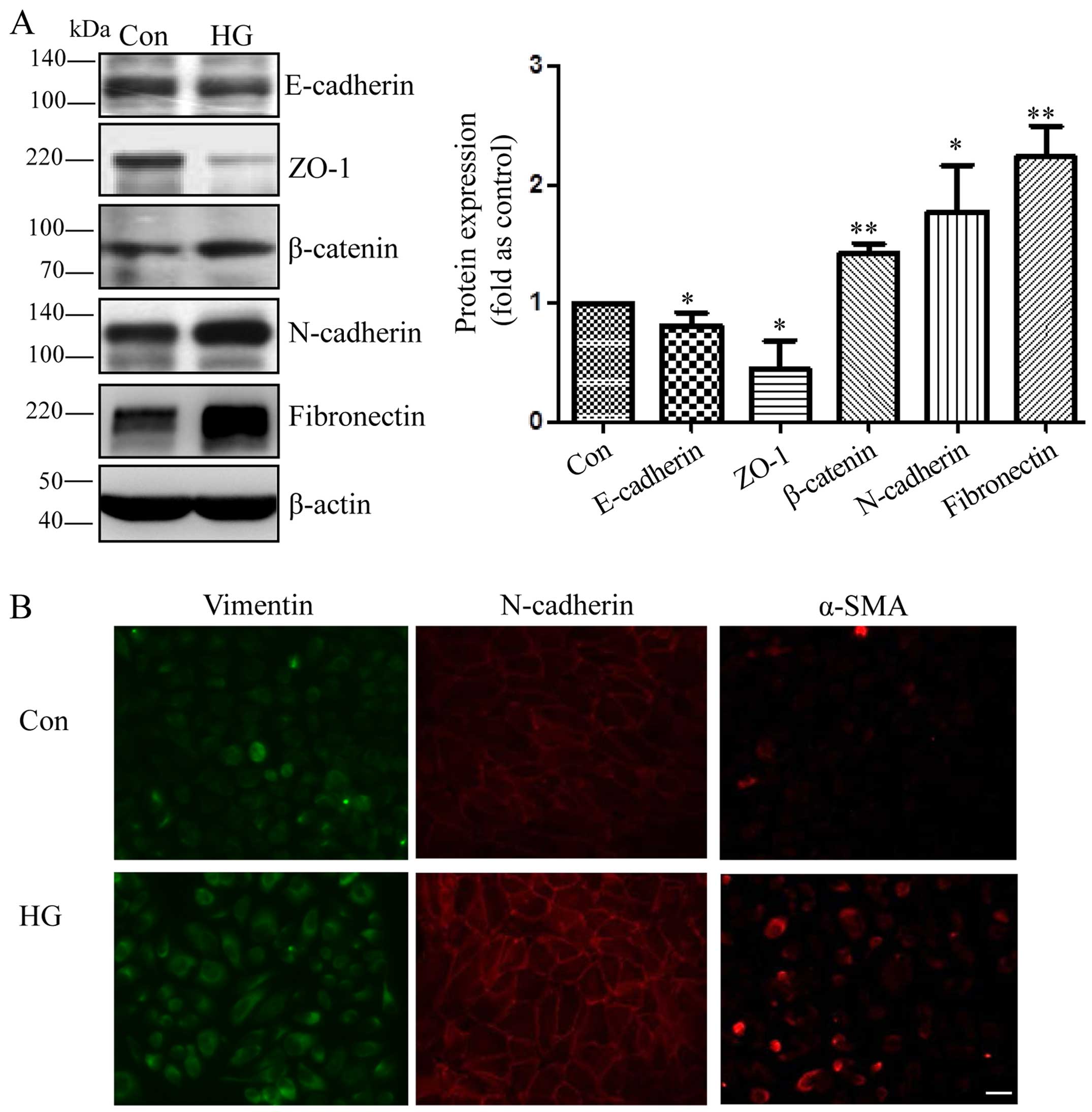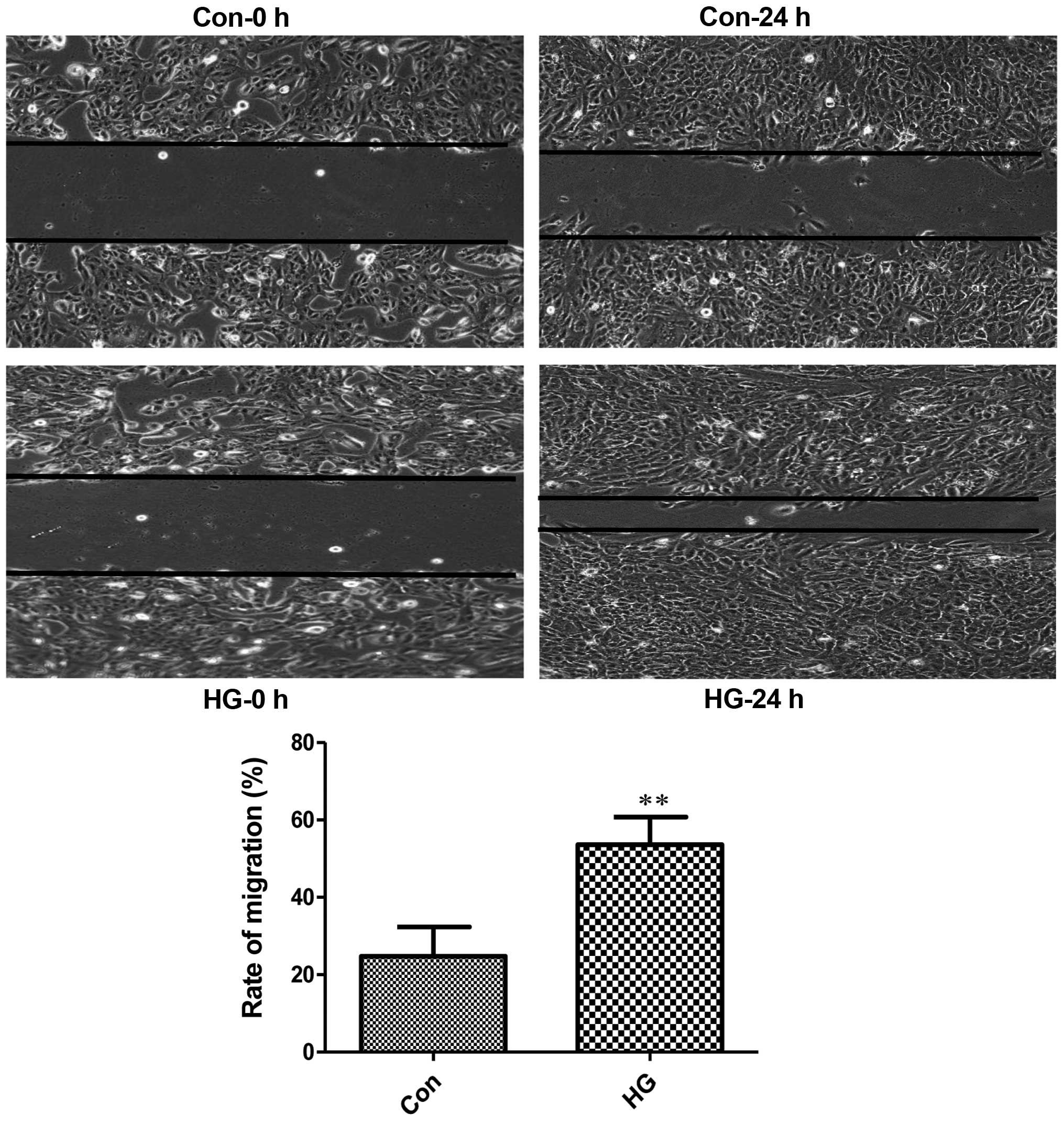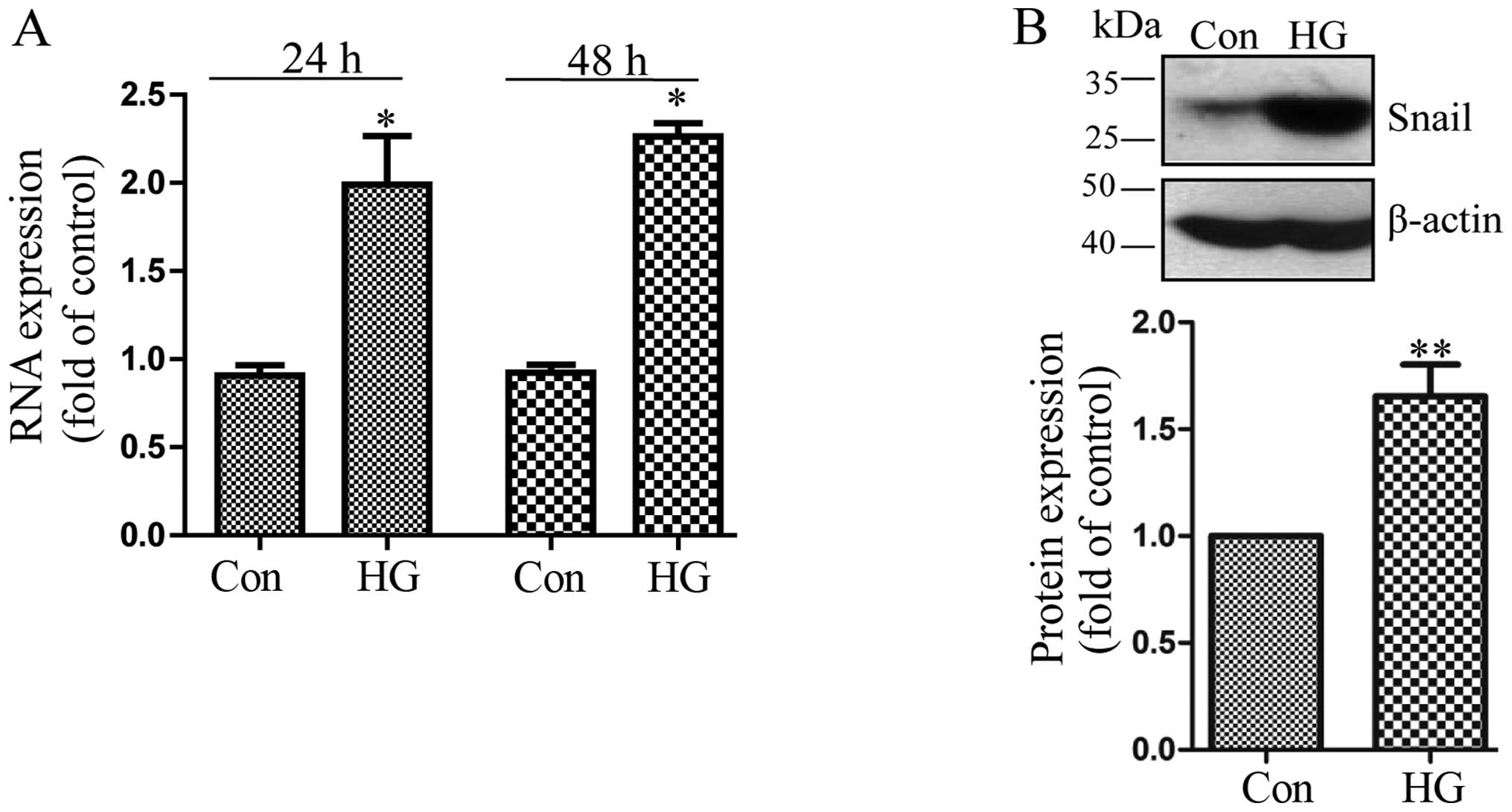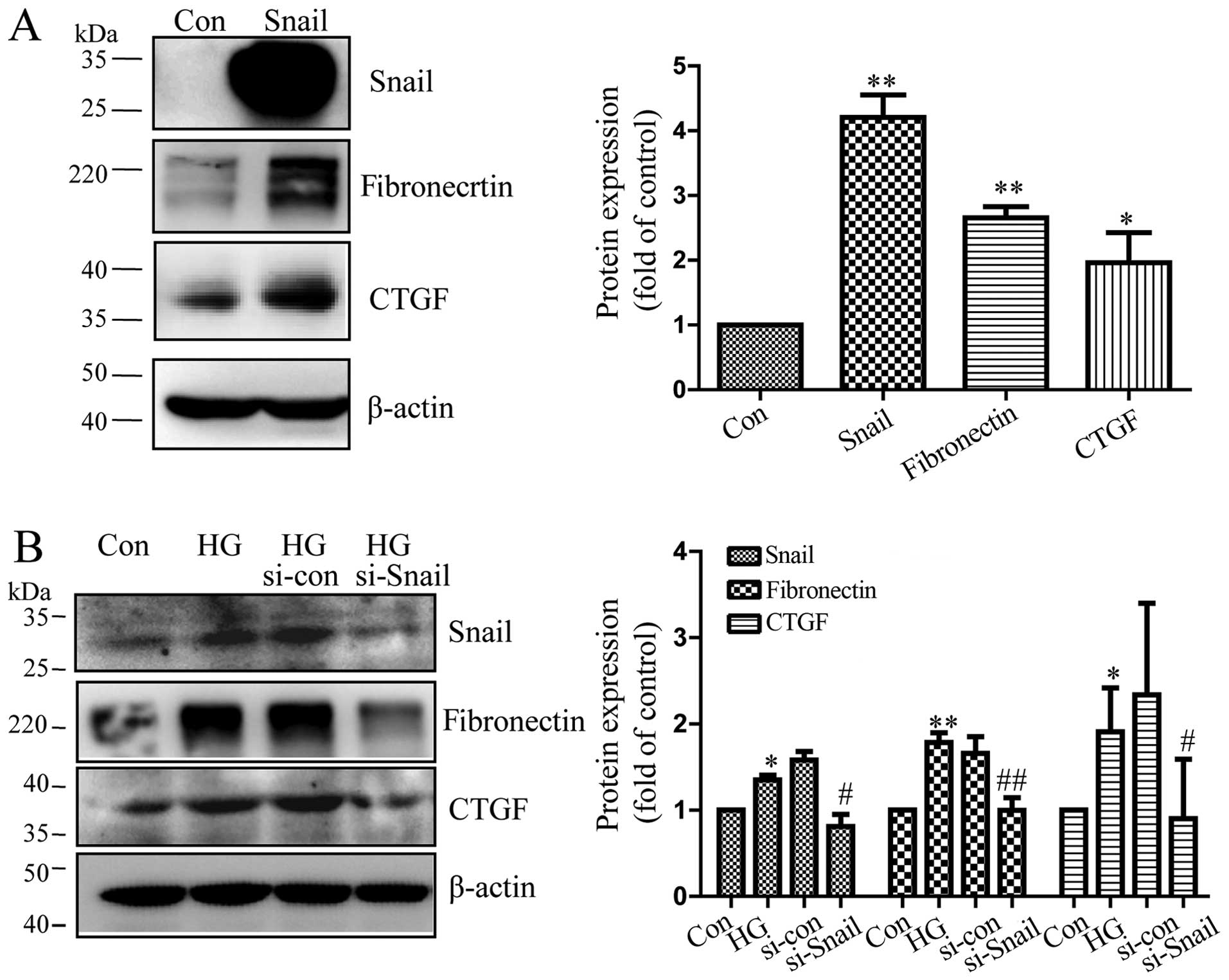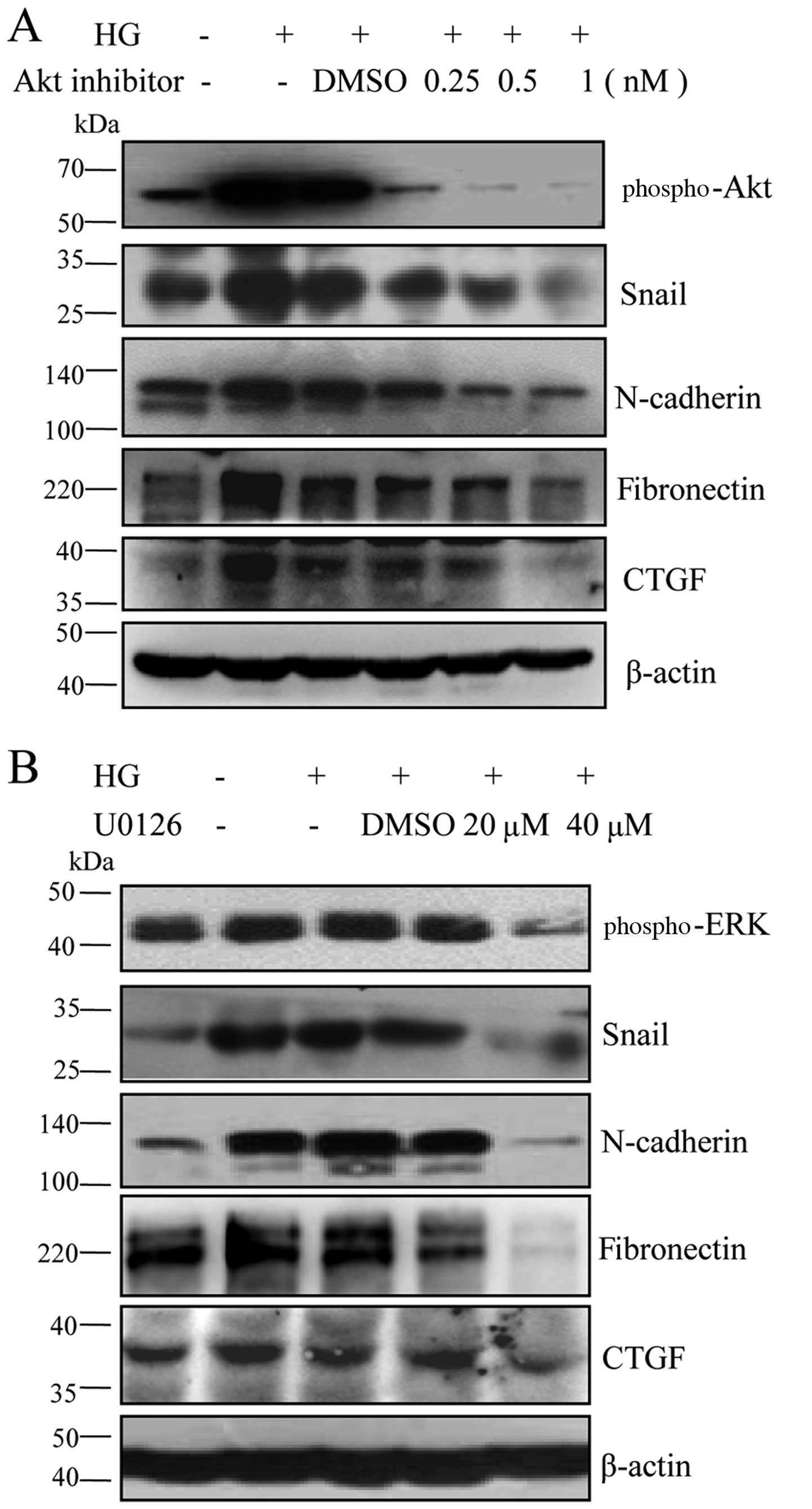High glucose-induced epithelial-mesenchymal transition contributes to the upregulation of fibrogenic factors in retinal pigment epithelial cells
- Authors:
- Published online on: October 6, 2016 https://doi.org/10.3892/ijmm.2016.2768
- Pages: 1815-1822
Abstract
Introduction
Retinal pigment epithelial cells (RPE cells), which are located between the choroids and the neurosensory retina, form the outer blood-retinal barrier and play a crucial role in the pathological processes that leads to the loss of vision. RPE cells are activated by the breakdown of the outer blood-retinal barrier, and can undergo proliferation and migration and secrete extracellular matrix (ECM) molecules in vitreoretinal disorders, such as proliferative diabetic retinopathy (DR), proliferative vitreoretinopathy (PVR) and age-related macular degeneration (AMD) (1–3). RPE cells are known to contribute to inflammation and fibrosis in vitreoretinal disorders (4) and in the formation of fibrotic membranes (5).
It has been documented that epithelial-mesenchymal transition (EMT) plays a role in the fibrosis of various organs, such as the kidneys, lungs and liver (6–9). There is evidence to suggest that kidney proximal tubule epithelial cells undergo EMT to induce interstitial fibrosis in diabetic nephropathy (6,10). As shown in a previous study, in diabetic nephropathy, the expression of mesenchymal proteins was detected in the kidney sections of diabetic patients, and the alterations in mesenchymal proteins in tubular epithelial cells were well correlated with the declining renal function (11). Since cells undergoing EMT will lose their normal functions and mediate fibrosis in diabetic nephropathy, we speculated that mesenchymal transition may be involved in the development of RPE cell-related diseases.
EMT is a multi-step morphogenetic process during which epithelial cells lose their epithelial properties and acquire mesenchymal characteristics. Static epithelial cells lose cell to cell junctions, and consequently they lose apico-basal polarity to become migratory mesenchymal-like cells (12,13). EMT occurs in three different biological settings with very different functional consequences (14). Type 1 EMT is invloved in original embryonic development and postnatal growth (12,15). Type 2 EMT participates in wound healing, tissue regeneration and organ fibrosis. Oncogenic (type 3) EMT enables epithelial cells to acquire invasive mesenchymal phenotype characteristics that are essential in the metastatic spread (16). The most characterized transcription factors in the regulation of EMT are Snail, Slug, Twist, zinc finger E-box-binding homeobox (ZEB)1 and ZEB2 (12,14).
EMT is triggered by inflammatory cytokines, cytotoxic stress and DNA damage in tissue repair and tissue fibrosis (17,18). Abundant evidence indicates that hyperglycemia is etiologically related to human aging and diseases, including DR and AMD (19), and high glucose is a predictor of progression to late AMD (20). Therefore, the aim of this study was to examine the effects of high glucose on EMT in RPE cells and to determine its pathogenic role.
Materials and methods
Materials and antibodies
L-glucose and D-glucose were purchased from Sigma (St. Louis, MO, USA). AKT inhibitor IV and the extracellular signal-regulated kinase (ERK) inhibitor, U0126, were obtained from Millipore (Billerica, MA, USA) and Selleckchem (Houston, TX, USA) respectively. Antibodies to α-smooth muscle actin (α-SMA; A2547) and β-actin (A5441) were purchased from Sigma-Aldrich. The antibody against phosphorylated (p-)ERK (sc-7383) was from Santa Cruz Biotechnology, Inc. (Santa Cruz, CA, USA). Antibodies against E-cadherin (610181), vimentin (550513), N-cadherin (610920) and fibronectin (610077) were obtained from BD Biosciences (Franklin Lakes, NJ, USA). Antibodies against Snail (3879S), β-catenin (9582S) and p-AKT (4060S) were from Cell Signaling Technology (Danvers, MA, USA). The antibody against connective tissue growth factor (CTGF; ab6992) was purchased from Abcam (Cambridge, MA, USA). ZO1 antibody (40-2200) was obtained from Invitrogen Life Technologies, Carlsbad, CA, USA. Goat anti-mouse (PI-2000) or anti-rabbit (PI-1000) horseradish peroxidase (HRP)-labeled secondary antibodies were from Vector Laboratories (Burlingame, CA, USA). Alexa Fluor 488 goat anti-rabbit/anti-mouse (A21206/A21202), Alexa Fluor 594 goat anti-rabbit/anti-mouse (A21207/A21203) antibodies and 4′,6-diamidino-2-phenylindole (DAPI; D1306) were from Life Technologies (St. Louis, MO, USA).
Cell culture
ARPE19, a cell line derived from human retinal pigment epithelium (RPE) was obtained from ATCC (Manassas, VA, USA) and cultured in Dulbecco's modified Eagle's medium (DMEM) containing 10% heat inactivated fetal bovine serum (FBS) and 100 U/ml penicillin/streptomycin (Invitrogen Life Technologies). The cells were maintained at 37°C in a humidified atmosphere with 5% CO2.
Immunofluorescence staining
Immunofluorescence staining was performed as previously described (21). For immunocytochemistry, the cells grown in 4-well glass slide chambers to 60% confluence were exposed to 25 mM high glucose for 48 h. The cells were then incubated with the primary antibodies specific for vimentin, N-cadherin and α-SMA at a dilution of 1:200 overnight at 4°C. The secondary antibodies (Alexa Flour 488/Alexa Flour 594 goat anti-rabbit/anti-mouse) were then added at a dilution of 1:200 for 1 h. Slides were prepared with a mounting medium containing DAPI to counterstain the nucleus.
Western blot analysis
The cells were lysed for total protein extraction using RIPA buffer. The protein concentration was determined using a Bio-Rad DC protein assay kit (Bio-Rad Laboratories, Hercules, CA, USA) according to the manufacturer's instructions. The aliquots of equal amounts of protein were resolved by sodium dodecyl sulfate-polyacrylamide gel electrophoresis (SDS-PAGE) and transferred onto a PVDF membrane (Bio-Rad Laboratories). After blocking with 5% non-fat dry milk in Tris-buffered saline Tween-20 (TBST) for 1 h, the membrane was incubated overnight at 4°C with various primary antibodies. After washing with TBST, the membrane was incubated with the appropriate secondary antibody for 2 h. The membrane was again washed with TBST, and immunoblots were developed with the enhanced chemiluminescent reagents from Pierce/Thermo Fisher Scientific (Waltham, MA, USA) according to the manufacturer's instructions. Images were acquired using ImageQuant Las 4000 mini (GE Healthcare Bio-sciences, Pittsburgh, PA, USA) and densitometry was performed using ImageJ software and normalized to the β-actin levels.
Reverse transcription-quantitative PCR (RT-qPCR)
Total RNA was extracted from the cultured cells using TRIzol reagent according to the manufacturer's instructions (Invitrogen Life Technologies). Total RNA (500 ng) was used for reverse transcription using the PrimeScript® RT reagent kit (perfect real-time) (Takara Bio Inc., Otsu, Japan). The cDNA was used for quantitative PCR (qPCR) using SYBR® Premix Ex Taq™ (rerfect real-time) (Takara Bio Inc.) and a Roche capillary-based LightCycler® 2.0 system (Roche Diagnostics, Indianapolis, IN, USA). The specificity of the amplification reactions was confirmed by melting curve analysis. All expression data were normalized to those for β-actin. The data were quantified by the comparative threshold cycle (Ct) method for relative gene expression. The PCR cycling conditions were as follows: 95°C for 30 sec, 95°C for 5 sec and 60°C for 45 sec for 40 cycles. Primer sequences are as follows: human snail forward, TGCGCTACTGCTGCGCGAAT and reverse, GGGCTGCTGGAAGGTAAACTCTGGA; β-actin forward, GCACTCTTCCAGCCTTCCTT and reverse, GTTGG CGTACAGGTCTTTGC.
Wound healing assay
The cells were seeded in each well of a 6-well culture plate and then cultured for 24 h until they reached approximately 80% confluence. The cells were starved in DMEM for 24 h and then exposed to L-glucose as a control and D-glucose (25 mM) for 48 h. Images of the wells under a microscope (Zeiss Axio Observer Z1, Carl Zeiss Meditec AG, Jena, Germany) were acquired the indicated time points after the wound scratch was made. The migration rate of the cells was calculated as the distance traveled by the cells from the wound edge to the cell-free space.
RNA interference
Oligonucleotides matching the selected regions of human Snail and scrambled siRNAs that were used as a negative control were purchased from RiboBio (Guangzhou, China). The cells were transfected with siRNA oligonucleotides at a final concentration of 100 nM with HiPerFect (Qiagen, Carson City, CA, USA) according to the manufacturer's instructions. The cells were transfected with siRNA oligonucleotides for 24 h then followed by incubation in the presence of high glucose for an additional 48 h.
Cell transfection with overexpression vector
Full-length Snail cDNA was a gift from Professor Jun Li (Sun Yat-sen University, Guangzhou, China). The pCR3.1-vector and pCR3.1-Snail plasmid were transfected into the cells using Lipofectamine 2000 according to the manufacturer's instructions (Invitrogen Life Technologies). After 48 h, the cells were harvested, and the expression of proteins was determined using western blot analysis.
Statistical analysis
Data are presented as the means ± SD. Comparisons were performed by a two-tailed paired Student's t-test. A value of p<0.05 was considered to indicate a statistically significant difference.
Results
EMT is induced by high glucose in RPE cells
RPE cells are the key component of the outer blood-retina barrier and the main contributor to the development of fibrotic tissue in the retina (22). Therefore, we evaluated the direct effect of high glucose on mesenchymal transition in RPE cells. As shown in Fig. 1, compared to exposure to L-glucose as an osmotic control, exposure to 25 mM high glucose for 48 h elevated the levels of N-cadherin, β-catenin, fibronectin and decreased the levels of E-cadherin and ZO-1 in the RPE cells (Fig. 1A). Moreover, immunofluorescence staining revealed that the cells exposed to high glucose had more intensive vimentin, N-cadherin and α-SMA signals compared with the control cells (Fig. 1B).
It is well known that EMT can increase cell motility (23–25). Normal RPE cells are quiescent without migration (26,27). In this study, the number of migrated cells in the high glucose-exposed RPE cells was considerably higher than the mean number of migrated control cells (Fig. 2). These observations indicated that the RPE cells exposed to high glucose underwent mesenchymal transition and migration was initiated.
Exposure to high glucose induces the upregulation of Snail
Snail is a classical transcription factor involved in EMT in tumors (14). Therefore, in this study, we investigated whether the expression of Snail was upregulated by exposure of the cells to high glucose. We found that compared to the control cells, high glucose increased the mRNA expression of Snail 24 h following exposure and reached the highest level at 48 h (Fig. 3A). Likewise, the promoting effect of high glucose on the Snail protein level at 48 h was also confirmed by western blot analysis (Fig. 3B).
Snail promotes the expression of cytokines in RPE cells
CTGF and fibronectin are important profibrotic growth factors that induce the production of ECM components and angiogenesis (28,29). CTGF and fibronectin have been implicated in the pathological progress in patients with vitreoretinal disorders (30–34) and is induced by high glucose (31,35). It has been reported that EMT is associated with fibrogenesis in diabetic nephropathy and other organs (6–9). In order to fully understand the pathogenic role of mesenchymal transition in RPE cells, we transfected the cells with Snail expression vector. Our results revealed that the protein level of Snail was upregulated in the cells transfected with the Snail overexpression vector compared to the cells transfected with the empty vector (Fig. 4A). In addition, with the overexpression of Snail, the expression of fibronectin and CTGF also increased in RPE cells, as shown by western blot analysis (Fig. 4A). Furthermore, compared to controls transfected with scrambled siRNA, the silencing of Snail decreased expression of CTGF and fibronectin in RPE cells, which had been increased by high glucose (Fig. 4B). These data suggested that mesenchymal transition in RPE cells may contribute to fibrosis by promoting the secretion of important cytokines.
The AKT and ERK signaling pathways mediate the expression of mesenchymal markers induced by high glucose in RPE cells
The activation AKT and ERK plays a critical role in the process of epithelial-mesenchymal transition (36–38). The AKT and ERK pathways have been recently recognized as new players in retinal disorders (39–41). These findings led us to hypothesize that the AKT and ERK signaling pathways regulate the expression of mesenchymal markers in RPE cells. To confirm the hypothesis, we used the AKT, AKT inhibitor IV and the ERK inhibitor, U0126, to block these signaling pathways. Our results revealed that AKT inhibitor IV and U0126 downregulated the levels of Snail and N-cadherin in a dose-dependent manner, followed by a decrease in the levels of CTGF and fibronectin (Fig. 5). These data indicated that the AKT and ERK signaling pathways were involved in the high glucose-induced mesenchymal transition and fibrosis in RPE cells.
Discussion
The present study reports that hyperglycemia induces mesenchymal transition in cultured RPE cells. The overexpression of Snail increased the protein levels of fibronectin and CTGF. Likewise, the silencing of Snail using siRNA decreased the expression of fibronectin and CTGF which was induced by high glucose in RPE cells. Mechanism experiments indicated that blockade of the AKT and ERK signaling pathways using chemical inhibitors decreased the expression of Snail, as well as that of fibronectin and CTGF, which had been induced by high glucose in RPE cells.
EMT is observed in the process of renal interstitial fibrosis, of pulmonary fibrosis, of liver fibrosis, or in specific ocular tissue (6–11). Most vision loss occurs following the transition from a disease of inflammation to a disease of neovascular fibrosis (42). RPE cells form the outer blood retinal barrier from the choroidal capillary bed by separating the outer retina. The dysfunction of the RPE can result in retinal edema, detachment or degeneration (43). Normal RPE cells are quiescent without proliferation or migration abilities (26,27). In this study, we found that high glucose induced the expression of mesenchymal makers in RPE cells (Fig. 1). Subsequently, the activated RPE cells induced by high glucose underwent migration (Fig. 2). Moreover, it has been proposed that hyperglycemia increases superoxide production, which in turn initiates accelerated advanced glycation end-product (AGE) formation and exacerbates interrelated pathogenic responses. AGEs are one of the important factors involved in the pathogenesis of diseases of the eye, and it has been demonstrated that AGE mimetic administration induces the breakdown of RPE function in RPE cells (44). We speculated that the pathogenic role of AGE in RPE was partially ascribed to the induction of mesenchymal transition. In this study, we verified that AGE-stimulated cells displayed an altered mesenchymal morphology with a decreased expression of E-cadherin and an increased expression of vimentin by immunofluorescence staining. AGE significantly elevated the Snail mRNA level (data not shown).
Cao et al newly proved the existence endothelial to mesenchymal transition (EndMT) in diabetic retinas (45). Our data, together with their study extend our understaning of mesenchymal transition specific to diabetic retinas. These observations indicate that retinal cells in the setting of hyperglycemia undergo mesenchymal transition, and this may be the initial and key event that is responsible for cellular dysfunction and the development of vitreoretinal diseases.
In this study, we demonstrated that hyperglycemia induced the cell transition from a normal phenotype to a mesenchymal phenotype and promoted Snail expression (Fig. 3). It would be of interest to determine the consequence of this transition concerning the pathogenic progress. In this study, to the best of our knowledge, we demonstrate for the first time that Snail regulated the expression of CTGF and fibronectin, which are important fibrogenic factors produced by RPE cells (Fig. 4). Due to the location of these cells, we hypothesized that the occurrence of mesenchymal transition in RPE cells would lead to the production of cytokines that results in indirect effects on the retina. Moreover, we hypothesized that mesenchymal transition leads to the cellular dysfunction partly through abnormal cytokine secretion and may participate in the functions of retinal cells, namely their fuctions other than fibrosis, such as intraretinal micovasular abnormalities.
This point warrants further investigation. Furthermore, recent studies have reported that CTGF itself induces EMT in renal cells (46,47). If this is also the case in retinal cells, we can assume that CTGF and Snail form a positive loop, resulting in a vicious circle of the development of vitreoretinal disorders.
Transforming growth factor (TGF)-β has been shown to play a central role in initiating EMT, and has been extensively studied. Therefore, we expected to elucidate a novel mechanism other than TGF-β, which could modulate mesenchymal transition in RPE cells. Recent data indicate that the normal epithelial phenotype and cell proliferation and migration appear to be associated with the activation of AKT and ERK via their phosphorylation (36,38). The connection between AKT and Snail and cell-cell adhesion plays a role in various tumors, as well as in the repair of normal tissue after wounding (48). Moreover, the Ras-ERK pathway is required for EMT, and it cooperates with other pathways to upregulate the expression of EMT-related genes, including mesenchymal genes and transcriptional repressors (e.g. Snail, Slug, Twist and ZEB) (37). However, these studies were confined to EMT in tumors. It is unknown as to which signaling pathways are involved in mesenchymal transition in RPE cells. In this study, we found that high glucose induced AKT and ERK phosphorylation followed by the induction of Snail and N-cadherin expression, as well as that of fibrogenic factors, while the blockade of the signaling pathways decreased the expression of Snail, N-cadherin, fibronectin and CTGF (Fig. 5). These findings indicated a novel mechanism through which the AKT and ERK signaling pathways modulate RPE dysfunction, relying on the regulation of mesenchymal transition, and that the signaling pathways may cooperate with each other.
In conclusion, the findings of our study, to the best of our knowledge, demonstrate for the first time that high glucose induces mesenchymal transition in RPE cells and suggest that the AKT and ERK signaling pathways regulate the expression of mesenchymal markers in RPE cells.
Acknowledgments
This study was supported by the National Nature Science Foundation of China, grant nos. 81200706, 81172163, 81272338, 81272515, 81400639, 81370945, 81471033, 81572342, 81570871 and 81570764; the National Key Sci-Tech Special Project of China, grant no. no. 2013ZX09102-053; the Program for Doctoral Station in University, grant nos. 20120171110053 and 20130171110053; the Fundamental Research Funds for the Central Universities' Youth Cultivation Project of China, grant no. 50000-3161046; the Guangdong Natural Science Fund, grant nos. S2012040006986, S2012010009250 and 2015A030313103; and the Key Sci-Tech Research Project of Guangzhou Municipality, China, grant nos. 2011Y1-00017-8, 12A52061519 and 201508020033.
References
|
Campochiaro PA: Pathogenic mechanisms in proliferative vitreoretinopathy. Arch Ophthalmol. 115:237–241. 1997. View Article : Google Scholar : PubMed/NCBI | |
|
Esser P, Heimann K, Bartz-schmidt KU, Fontana A, Schraermeyer U, Thumann G and Weller M: Apoptosis in proliferative vitreoretinal disorders: Possible involvement of TGF-beta-induced RPE cell apoptosis. Exp Eye Res. 65:365–378. 1997. View Article : Google Scholar : PubMed/NCBI | |
|
Miller H, Miller B and Ryan SJ: The role of retinal pigment epithelium in the involution of subretinal neovascularization. Invest Ophthalmol Vis Sci. 27:1644–1652. 1986.PubMed/NCBI | |
|
Bastiaans J, van Meurs JC, van Holten-Neelen C, Nijenhuis MS, Kolijn-Couwenberg MJ, van Hagen PM, Kuijpers RWAM, Hooijkaas H and Dik WA: Factor Xa and thrombin stimulate proinflammatory and profibrotic mediator production by retinal pigment epithelial cells: A role in vitreoretinal disorders? Graefes Arch Clin Exp Ophthalmol. 251:1723–1733. 2013. View Article : Google Scholar : PubMed/NCBI | |
|
Qin D, Zhang GM, Xu X and Wang LY: The PI3K/Akt signaling pathway mediates the high glucose-induced expression of extracellular matrix molecules in human retinal pigment epithelial cells. J Diabetes Res. 2015:9202802015. View Article : Google Scholar : PubMed/NCBI | |
|
Carew RM, Wang B and Kantharidis P: The role of EMT in renal fibrosis. Cell Tissue Res. 347:103–116. 2012. View Article : Google Scholar | |
|
Nowrin K, Sohal SS, Peterson G, Patel R and Walters EH: Epithelial-mesenchymal transition as a fundamental underlying pathogenic process in COPD airways: Fibrosis, remodeling and cancer. Expert Rev Respir Med. 8:547–559. 2014. View Article : Google Scholar : PubMed/NCBI | |
|
Chapman HA: Epithelial-mesenchymal interactions in pulmonary fibrosis. Annu Rev Physiol. 73:413–435. 2011. View Article : Google Scholar | |
|
Lee SJ, Kim KH and Park KK: Mechanisms of fibrogenesis in liver cirrhosis: The molecular aspects of epithelial-mesenchymal transition. World J Hepatol. 6:207–216. 2014. View Article : Google Scholar : PubMed/NCBI | |
|
Srivastava SP, Koya D and Kanasaki K: MicroRNAs in kidney fibrosis and diabetic nephropathy: Roles on EMT and EndMT. BioMed Res Int. 2013:1254692013. View Article : Google Scholar : PubMed/NCBI | |
|
Liu Y: New insights into epithelial-mesenchymal transition in kidney fibrosis. J Am Soc Nephrol. 21:212–222. 2010. View Article : Google Scholar | |
|
Samatov TR, Tonevitsky AG and Schumacher U: Epithelial-mesenchymal transition: Focus on metastatic cascade, alternative splicing, non-coding RNAs and modulating compounds. Mol Cancer. 12:1072013. View Article : Google Scholar : PubMed/NCBI | |
|
Kalluri R and Weinberg RA: The basics of epithelial- mesenchymal transition. J Clin Invest. 119:1420–1428. 2009. View Article : Google Scholar : PubMed/NCBI | |
|
Zeisberg M and Neilson EG: Biomarkers for epithelial-mesenchymal transitions. J Clin Invest. 119:1429–1437. 2009. View Article : Google Scholar : PubMed/NCBI | |
|
Chaffer CL, Thompson EW and Williams ED: Mesenchymal to epithelial transition in development and disease. Cells Tissues Organs. 185:7–19. 2007. View Article : Google Scholar : PubMed/NCBI | |
|
Thiery JP: Epithelial-mesenchymal transitions in tumour progression. Nat Rev Cancer. 2:442–454. 2002. View Article : Google Scholar : PubMed/NCBI | |
|
Hirasawa M, Noda K, Noda S, Suzuki M, Ozawa Y, Shinoda K, Inoue M, Ogawa Y, Tsubota K and Ishida S: Transcriptional factors associated with epithelial-mesenchymal transition in choroidal neovascularization. Mol Vis. 17:1222–1230. 2011.PubMed/NCBI | |
|
Thiery JP and Sleeman JP: Complex networks orchestrate epithelial-mesenchymal transitions. Nat Rev Mol Cell Biol. 7:131–142. 2006. View Article : Google Scholar : PubMed/NCBI | |
|
Chiu CJ and Taylor A: Dietary hyperglycemia, glycemic index and metabolic retinal diseases. Prog Retin Eye Res. 30:18–53. 2011. View Article : Google Scholar | |
|
Ghaem Maralani H, Tai BC, Wong TY, Tai ES, Li J, Wang JJ and Mitchell P: Metabolic syndrome and risk of age-related macular degeneration. Retina. 35:459–466. 2015. View Article : Google Scholar | |
|
Zhou T, Hu Y, Chen Y, Zhou KK, Zhang B, Gao G and Ma JX: The pathogenic role of the canonical Wnt pathway in age-related macular degeneration. Invest Ophthalmol Vis Sci. 51:4371–4379. 2010. View Article : Google Scholar : | |
|
Snead DR, James S and Snead MP: Pathological changes in the vitreoretinal junction 1: Epiretinal membrane formation. Eye (Lond). 22:1310–1317. 2008. View Article : Google Scholar | |
|
Hazan RB, Phillips GR, Qiao RF, Norton L and Aaronson SA: Exogenous expression of N-cadherin in breast cancer cells induces cell migration, invasion, and metastasis. J Cell Biol. 148:779–790. 2000. View Article : Google Scholar : PubMed/NCBI | |
|
Williams E, Williams G, Gour BJ, Blaschuk OW and Doherty P: A novel family of cyclic peptide antagonists suggests that N-cadherin specificity is determined by amino acids that flank the HAV motif. J Biol Chem. 275:4007–4012. 2000. View Article : Google Scholar : PubMed/NCBI | |
|
De Wever O, Westbroek W, Verloes A, Bloemen N, Bracke M, Gespach C, Bruyneel E and Mareel M: Critical role of N-cadherin in myofibroblast invasion and migration in vitro stimulated by colon-cancer-cell-derived TGF-beta or wounding. J Cell Sci. 117:4691–4703. 2004. View Article : Google Scholar : PubMed/NCBI | |
|
Bharti K, Nguyen MT, Skuntz S, Bertuzzi S and Arnheiter H: The other pigment cell: specification and development of the pigmented epithelium of the vertebrate eye. Pigment Cell Res. 19:380–394. 2006. View Article : Google Scholar : PubMed/NCBI | |
|
Strauss O: The retinal pigment epithelium in visual function. Physiol Rev. 85:845–881. 2005. View Article : Google Scholar : PubMed/NCBI | |
|
Winkler JL, Kedees MH, Guz Y and Teitelman G: Inhibition of connective tissue growth factor by small interfering ribonucleic acid prevents increase in extracellular matrix molecules in a rodent model of diabetic retinopathy. Mol Vis. 18:874–886. 2012.PubMed/NCBI | |
|
Austin BA, Liu B, Li Z and Nussenblatt RB: Biologically active fibronectin fragments stimulate release of MCP-1 and catabolic cytokines from murine retinal pigment epithelium. Invest Ophthalmol Vis Sci. 50:2896–2902. 2009. View Article : Google Scholar : PubMed/NCBI | |
|
Kothary PC, Badhwar J, Weng C and Del Monte MA: Impaired intracellular signaling may allow upregulation of CTGF-synthesis and secondary peri-retinal fibrosis in human retinal pigment epithelial cells from patients with age-related macular degeneration. Adv Exp Med Biol. 664:419–428. 2010. View Article : Google Scholar | |
|
Tikellis C, Cooper ME, Twigg SM, Burns WC and Tolcos M: Connective tissue growth factor is upregulated in the diabetic retina: Amelioration by angiotensin-converting enzyme inhibition. Endocrinology. 145:860–866. 2004. View Article : Google Scholar | |
|
Kuiper EJ, Witmer AN, Klaassen I, Oliver N, Goldschmeding R and Schlingemann RO: Differential expression of connective tissue growth factor in microglia and pericytes in the human diabetic retina. Br J Ophthalmol. 88:1082–1087. 2004. View Article : Google Scholar : PubMed/NCBI | |
|
Cherian S and Roy S, Pinheiro A and Roy S: Tight glycemic control regulates fibronectin expression and basement membrane thickening in retinal and glomerular capillaries of diabetic rats. Invest Ophthalmol Vis Sci. 50:943–949. 2009. View Article : Google Scholar | |
|
Roy S, Cagliero E and Lorenzi M: Fibronectin overexpression in retinal microvessels of patients with diabetes. Invest Ophthalmol Vis Sci. 37:258–266. 1996.PubMed/NCBI | |
|
Hughes JM, Kuiper EJ, Klaassen I, Canning P, Stitt AW, Van Bezu J, Schalkwijk CG, Van Noorden CJ and Schlingemann RO: Advanced glycation end products cause increased CCN family and extracellular matrix gene expression in the diabetic rodent retina. Diabetologia. 50:1089–1098. 2007. View Article : Google Scholar : PubMed/NCBI | |
|
Martinez G and de Iongh RU: The lens epithelium in ocular health and disease. Int J Biochem Cell Biol. 42:1945–1963. 2010. View Article : Google Scholar : PubMed/NCBI | |
|
Neuzillet C, Tijeras-Raballand A, de Mestier L, Cros J, Faivre S and Raymond E: MEK in cancer and cancer therapy. Pharmacol Ther. 141:160–171. 2014. View Article : Google Scholar | |
|
Yuan L, Hu J, Luo Y, Liu Q, Li T, Parish CR, Freeman C, Zhu X, Ma W, Hu X, et al: Upregulation of heparanase in high-glucose-treated endothelial cells promotes endothelial cell migration and proliferation and correlates with Akt and extracellular-signal-regulated kinase phosphorylation. Mol Vis. 18:1684–1695. 2012.PubMed/NCBI | |
|
Qin D, Zheng XX and Jiang YR: Apelin-13 induces proliferation, migration, and collagen I mRNA expression in human RPE cells via PI3K/Akt and MEK/Erk signaling pathways. Mol Vis. 19:2227–2236. 2013.PubMed/NCBI | |
|
Sasore T, Reynolds AL and Kennedy BN: Targeting the PI3K-Akt-mTOR pathway in ocular neovascularization. Adv Exp Med Biol. 801:805–811. 2014. View Article : Google Scholar | |
|
Yuan Z, Feng W, Hong J, Zheng Q, Shuai J and Ge Y: p38MAPK and ERK promote nitric oxide production in cultured human retinal pigmented epithelial cells induced by high concentration glucose. Nitric Oxide. 20:9–15. 2009. View Article : Google Scholar | |
|
Radeke MJ, Radeke CM, Shih YH, Hu J, Bok D, Johnson LV and Coffey PJ: Restoration of mesenchymal retinal pigmented epithelial cells by TGFβ pathway inhibitors: Implications for age-related macular degeneration. Genome Med. 7:582015. View Article : Google Scholar | |
|
Simó R, Villarroel M, Corraliza L, Hernández C and Garcia-Ramírez M: The retinal pigment epithelium: Something more than a constituent of the blood-retinal barrier - implications for the pathogenesis of diabetic retinopathy. J Biomed Biotechnol. 2010:1907242010. View Article : Google Scholar | |
|
Dahrouj M, Desjardins DM, Liu Y, Crosson CE and Ablonczy Z: Receptor mediated disruption of retinal pigment epithelium function in acute glycated-albumin exposure. Exp Eye Res. 137:50–56. 2015. View Article : Google Scholar : PubMed/NCBI | |
|
Cao Y, Feng B, Chen S, Chu Y and Chakrabarti S: Mechanisms of endothelial to mesenchymal transition in the retina in diabetes. Invest Ophthalmol Vis Sci. 55:7321–7331. 2014. View Article : Google Scholar : PubMed/NCBI | |
|
Sonnylal S, Xu S, Jones H, Tam A, Sreeram VR, Ponticos M, Norman J, Agrawal P, Abraham D and de Crombrugghe B: Connective tissue growth factor causes EMT-like cell fate changes in vivo and in vitro. J Cell Sci. 126:2164–2175. 2013. View Article : Google Scholar : PubMed/NCBI | |
|
Yang Z, Sun L, Nie H, Liu H, Liu G and Guan G: Connective tissue growth factor induces tubular epithelial to mesenchymal transition through the activation of canonical Wnt signaling in vitro. Ren Fail. 37:129–135. 2015. View Article : Google Scholar | |
|
Qiao M, Sheng S and Pardee AB: Metastasis and AKT activation. Cell Cycle. 7:2991–2996. 2008. View Article : Google Scholar : PubMed/NCBI |



